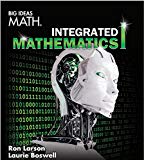
Concept explainers
To calculate: The next three terms for the arithmetic sequence
Answer to Problem 48E
The next three terms of the arithmetic sequence are
Explanation of Solution
Given information:
The arithmetic sequence
Formula used:
A sequence with first term as
Calculation:
Consider the arithmetic sequence
Recall that a sequence with first term as
Compute the difference between the consecutive terms,
And
Therefore, common difference is
Now, sixth term is,
Now, seventh term is,
And, eight term is,
Thus, the next three terms of the arithmetic sequence are
Chapter 5 Solutions
BIG IDEAS MATH Integrated Math 1: Student Edition 2016
- An alligator has a body length of six and 5 tenths feet and a tail length of seven and one fourth feet. How long is the alligatorarrow_forward1. Compute Lo F⚫dr, where and C is defined by F(x, y) = (x² + y)i + (y − x)j r(t) = (12t)i + (1 − 4t + 4t²)j from the point (1, 1) to the origin.arrow_forwardIf AB = 10 and AC = 13, what is AD? B A D C Write your answer as a whole number or as a decimal rounded to the nearest hundredth.arrow_forward
- 3 Evaluate the determinants 5 17 3 0 1 2 -10-30 (a) 2 4-3 (b) -2 3 0 1 11 0 2 10-10arrow_forwardOne deck of cards is made of 4 suits (Spade, Diamond, Heart, Club) and 13 cards (A -> K), totaling 52 cards. A flush is a combination of 5 cards with the same suit. e.g. 3d 5d 9d Jd Kd A straight flush is a combination of 5 cards with the same suit, but also connected to each other. (e.g. highest straight flush is 10s Js Qs Ks As, the lowest straight flush is Ah, 2h, 3h, 4h, 5h) A straight flush is not considered a flush. Question 2 of 4 Draw random 5 cards (in one action) from the 52 cards deck, and calculate the probability of a flush. Provide the formula you used.arrow_forward2. Consider the vector force: F(x, y, z) = 2xye²i + (x²e² + y)j + (x²ye² — z)k. (A) [80%] Show that F satisfies the conditions for a conservative vector field, and find a potential function (x, y, z) for F. Remark: To find o, you must use the method explained in the lecture. (B) [20%] Use the Fundamental Theorem for Line Integrals to compute the work done by F on an object moves along any path from (0,1,2) to (2, 1, -8).arrow_forward
- Game: dropping marbles from a 100-floor tower, given unlimited amount of identical marbles. if marble breaks when dropped from level X -> it breaks from all levels higher than X if marble doesn't break when dropped from level Y -> no marbles will break when dropped from level lower than Y Goal of Game: Find the highest level, from which the marbles doesn't break. Please design a testing plan to minimize the worst-case number-of-tests required to find the answer, with the constraint you can only break max 2 marbles. What is the minimum number of tests required? Explain your testing plan and how you arrived at this number.arrow_forwardHeight = 1 Width=1 How much is the shaded area in the chart above?arrow_forward(a) Given z = x + jy determine if f (z) = z4 is analytic.(b) On an Argand Diagram sketch the region |z| < 1.(c) Map the region |z| < 1 into the function plane f (z) = U + jV , defined as f (z) = z4.arrow_forward
 Discrete Mathematics and Its Applications ( 8th I...MathISBN:9781259676512Author:Kenneth H RosenPublisher:McGraw-Hill Education
Discrete Mathematics and Its Applications ( 8th I...MathISBN:9781259676512Author:Kenneth H RosenPublisher:McGraw-Hill Education Mathematics for Elementary Teachers with Activiti...MathISBN:9780134392790Author:Beckmann, SybillaPublisher:PEARSON
Mathematics for Elementary Teachers with Activiti...MathISBN:9780134392790Author:Beckmann, SybillaPublisher:PEARSON
 Thinking Mathematically (7th Edition)MathISBN:9780134683713Author:Robert F. BlitzerPublisher:PEARSON
Thinking Mathematically (7th Edition)MathISBN:9780134683713Author:Robert F. BlitzerPublisher:PEARSON Discrete Mathematics With ApplicationsMathISBN:9781337694193Author:EPP, Susanna S.Publisher:Cengage Learning,
Discrete Mathematics With ApplicationsMathISBN:9781337694193Author:EPP, Susanna S.Publisher:Cengage Learning, Pathways To Math Literacy (looseleaf)MathISBN:9781259985607Author:David Sobecki Professor, Brian A. MercerPublisher:McGraw-Hill Education
Pathways To Math Literacy (looseleaf)MathISBN:9781259985607Author:David Sobecki Professor, Brian A. MercerPublisher:McGraw-Hill Education





